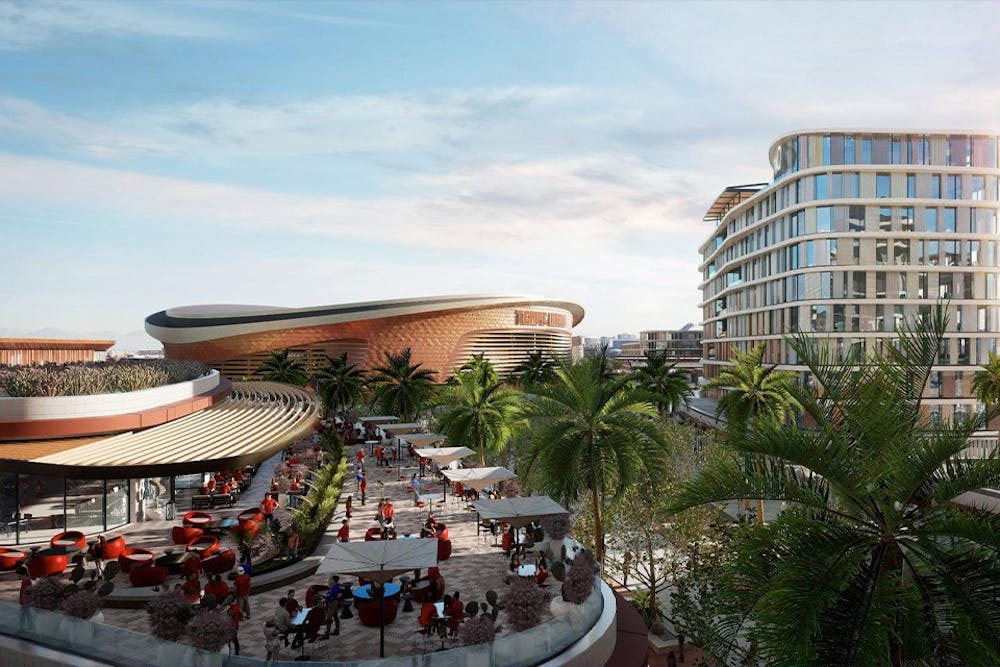Two conflicting reports released this week examine the potential economic impact of the Tempe entertainment district — one said there would be economic strain to the community upon the project's completion, while the other said it would generate billions of dollars for the city.
The reviews, done by the Grand Canyon Institute and ASU's W.P. Carey School of Business L. William Seidman Research Institute, differ widely in predicting the potential economic and employment impact as well as the longevity of the entertainment district.
The proposed Tempe entertainment district would include nearly 2,000 apartments and a new hockey arena for the Arizona Coyotes with 16,000 seats on about 46 acres of land with other businesses and retail locations on the northeast corner of Priest Drive and Rio Salado Parkway.
The three propositions on the ballot for the May 16 mail-in special election regarding the proposed entertainment district address land use and enter the city of Tempe into an agreement with a development company to create it.
Ballots will be mailed to residents on Wednesday, April 19 and must be mailed back by May 9. Replacement ballots may be cast in person from May 8 through 16 if the mailed ballot was lost, spoiled, destroyed or not received.
READ MORE: Tempe special election for Arizona Coyotes arena and entertainment district, explained
Seidman Research Institute report
The Seidman Institute is a consulting wing of the W. P. Carey School established to serve as a resource for private and public businesses, according to its website. The Institute was contracted to produce a report commissioned and paid for by the Arizona Coyotes' development team.
Longtime ASU professor in the department of economics and director of the Seidman Institute, Dennis Hoffman, said his role in the report was largely in an auditing capacity, rather than as a primary author of research.
The report was produced in a relatively short window compared to the time it takes to produce a full study. In just 10 days, the team reviewed reports previously done by Conventions, Sports & Leisure International, which was also commissioned by the Coyotes, and Hunden Strategic Partners, commissioned by the city of Tempe.
The CSL report concluded the arena and entertainment district would net a total of $12.5 billion in output over the construction period and the following 30 years.
"We only undertake these projects with the understanding that we have complete independence in terms of reaching the conclusions in our assessment," Hoffman said.
The Seidman report, obtained by The State Press as it has yet to be made available to the public, concluded the entertainment district will generate millions of dollars for Tempe and that because most of the construction would be privately funded, the previous Hunden and CSL reports had underestimated revenue projections.
The Seidman report determined that CSL had "taken a comprehensive approach in estimating economic impacts," but that it underestimated earnings per new net job by 36.5% and net sales tax tallies by $34 million. The CSL analysis said the development will create 6,900 jobs, and the Seidman report said that both reports were consistent with that number.
In a media alert from Mike Scerbo, a spokesperson for the Tempe Wins campaign in favor of the three propositions, said the Seidman review confirmed "there are no costs to the City of Tempe and the project is privately funded unlike every other sports facility in Arizona. ... Tempe general fund dollars are not being used to pay for any portion of the project, nor does the development require the imposition of new taxes — ever."
Hoffman, who produced the report, said his only experience with the entertainment district before producing the report was in analyzing it as a Tempe resident and voter. He said he was struck by the part of the proposal that said the entertainment district would be privately funded.
Grand Canyon Institute report
The Grand Canyon Institute is a non-partisan think tank that through analysis and review, publicizes the fiscal and other economic implications of policy initiatives.
According to the GCI report, the addition of a third arena to the Valley would create challenges for effective use rates of the two other sports venues — Footprint Center in Phoenix and Desert Diamond Arena in Glendale (formerly known as Gila River Arena). The three would likely compete, giving each less of an advantage in negotiations for booking live events.
The assumption of 45 events plus hockey games for the arena in the entertainment district may be optimistic, the report said, adding that a loss in events for other, long-standing venues may counteract the positive outcomes of adding the entertainment district into the mix.
In a press release, Dawn Penich-Thacker, a spokesperson for Tempe 1st, the grassroots campaign opposed to the entertainment district propositions, said the group was grateful to see an "unbiased economic analysis" that aligned with what the group believes.
"This proposed development is a financial drain on Tempe that can't possibly live up to the developer's rosy predictions," the statement said. "Tempe residents are better off rejecting this scheme so our city can start fresh and invite better, more responsible and profitable projects for our land."
The report, which took around two months to complete, found that the city will experience a "net drain, not a net gain" from the project. The study said for every $2.70 that goes from the city to the arena and music venue, the city will only get $1 on average in return. The report says this will hinder the growth of the city's general fund.
"We found that it just isn't lucrative enough to actually pay back it, so that's why it's a net loss to the city, which means that the city would not have missed the general fund," said Dave Wells, GCI research director. Wells is also a professor in the College of Integrative Sciences and Arts in leadership and integrative studies.
The GCI report also responded to prior reports from CSL and Hunden that the Coyotes and the city used months prior to make decisions, calling its numbers "arbitrary." GCI said the two previous reports failed to account for losses Tempe businesses may experience as a result of the new development.
It also said the effect will be more local, stating that the effect on the greater Phoenix metropolitan statistical area is negligible because the Coyotes have been established for 30 years. The report used a multiplier effect that represented the sales tax of Tempe rather than the greater metropolitan area.
Wells said the inside of the entertainment district would have a sales tax of upwards of 11% in order for the city to break even.
"The people that go are going to pay for it," Wells said.
GCI called the Seidman report a "pie in the sky." GCI's response said the Seidman report used a multiplier larger than what would represent Tempe, instead using one representing the entire Phoenix MSA. According to Wells, the Seidman report also double counted taxes for hotels instead of counting them correctly at one time.
"Nobody comes to visit Tempe because they built any hotel and businesses don't start out because somebody's gone to office space," Wells said. "In fact, the Seidman Institute actually has this fantastical economic return, I think is a poor use of economic impact, so that's one of the key drivers of why our results are lower than the other ones because those other things can happen."
Edward Pascual, senior real estate consultant for the Coyotes, said there are development options on a significant portion of the site where the entertainment district would be and they have been there since 1996.
"The site is a brownfield and the site requires so much upfront capital to remediate and to put in public infrastructure," Pascual said. "Once they do that, the land is worth less than the investment they put in. So when we're looking at these hypothetical scenarios … or potential scenarios down the road, those development scenarios have already had the opportunity to have been presented to the city, and they haven't been."
Wells said for voters who are struggling to know which report to look at in addition to all of the other noise about the entertainment district, it is difficult to measure the future, but he believes the GCI study is more accurate.
"Everybody should take all these numbers with a little bit of a grain of salt, meaning that none of this is very necessarily as precise as it might look like," Wells said.
Senior sports reporter Alex Wakefield contributed to the reporting of this article.
Edited by Reagan Priest, Greta Forslund and Anusha Natarajan.
Reach the reporters at pjhanse1@asu.edu and sbrenna5@asu.edu and follow @piperjhansen and @shanebrennan36 on Twitter.
Like The State Press on Facebook and follow @statepress on Twitter.

Piper Hansen is the digital editor-in-chief at The State Press, overseeing all digital content. Joining SP in Spring 2020, she has covered student government, housing and COVID-19. She has previously written about state politics for The Arizona Republic and the Arizona Capitol Times and covers social justice for Cronkite News.

Shane Brennan is the former Editor-in-Chief at The State Press and an ASU alum. He was a sports and politics reporter, before becoming the editor of the politics desk. He has covered local and state politics for the Arizona Capitol Times and Cronkite News.




